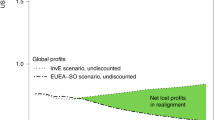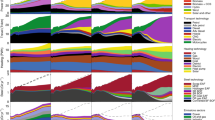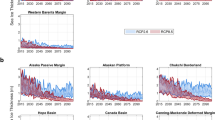Abstract
Computer-assisted technological innovation and breakthroughs in drilling are revolutionizing the energy landscape, creating greater uncertainty about the future trends for oil use. These new dynamics are prompting major oil producers to reconsider the commercial value of their assets, potentially changing the long-term outlook for oil prices. A shift in investment and production strategy by major oil-producing countries and large multinational companies to pre-empt the risk of stranded assets would have significant implications on energy markets. This Perspective surveys the competitive forces at play that are able to shift the dynamics of the global oil market and discusses their implications for US climate and energy policy. A declining long-term oil price might imply that energy and climate scientists and policymakers should revisit the road map of the optimum policies to promote the transition to lower carbon energy and to defend technology gains already achieved.
This is a preview of subscription content, access via your institution
Access options
Subscribe to this journal
Receive 12 digital issues and online access to articles
$119.00 per year
only $9.92 per issue
Buy this article
- Purchase on Springer Link
- Instant access to full article PDF
Prices may be subject to local taxes which are calculated during checkout

Similar content being viewed by others
References
Hoffert, M. I. Advanced technology paths to global climate stability: energy for a greenhouse planet. Science 298, 981–987 (2002).
Meinshausen, M. et al. Greenhouse-gas emission targets for limiting global warming to 2 °C. Nature 458 1158–1163 (2009).
Johansson, T. B., Nakicenovic, N., Patwardhan, A. & Gomez-Echeverri, L. (eds) Global Energy Assessment: Toward a Sustainable Future (Cambridge Univ. Press, 2012); http://go.nature.com/2cFv6e5
Reiner, D. M. Learning through a portfolio of carbon capture and storage demonstration projects. Nat. Energy 1, 15011 (2016).
Wade, T. Pioneer says some U. S. fracking costs competitive with Saudis. Reuters (29 July 2016); http://go.nature.com/2dtFAfi
U.S. Energy Intensity Projected to Continue its Steady Decline Through 2040 (US EIA, 2013); http://go.nature.com/2dmaXYB
Seba, T. Clean Disruption of Energy and Transportation (Clean Planet Ventures, 2014).
McGlade, C. & Ekins, P. The geographical distribution of fossil fuels unused when limiting global warming to 2 °C. Nature 517, 187–190 (2015).
Griffin, P. et al. Science and the stock market: investors’ recognition of unburnable carbon. Energy Econ. 52, 1–12 (2015).
Deffeyes, K. Hubbert's Peak: The Impending World Oil Shortage (Princeton Univ. Press, 2001).
Clayton, B. C. Market Madness: A Century of Oil Panics, Crises, and Crashes (Oxford Univ. Press, 2015).
Gately, D. OPEC's incentives for faster output growth. Energy J. 25, 75–96 (2004).
Neff, S. & Coleman, M. EIA outlook: reversal in U.S. oil import dependency. Energy Strategy Rev. 5, 6–13 (2014).
World Energy Outlook (International Energy Agency, 2015).
Energy Perspectives 2016 (Statoil, 2016); http://go.nature.com/2dl6Cc8
BP Technology Outlook (BP, 2015); http://go.nature.com/2d3xGLb
Darby, M. Total rules out Arctic oil drilling, citing 2C goal. Climate Home (24 May 2016); http://go.nature.com/2d0mp0G
Carbon Scenarios (ConocoPhillips, 2016); http://go.nature.com/2dwgEXh
Nykvist, B. Rapidly falling costs of battery packs for electric vehicles. Nat. Clim. Change 5, 329–332 (2015).
ExxonMobil's Outlook for Energy Sees Global Increase in Future Demand (ExxonMobil, 2014); http://go.nature.com/2cwnpDp
Wadud, Z., MacKenzie, D. & Leiby, P. Help or hindrance? The travel, energy and carbon impacts of highly automated vehicles. Transport. Res. A 86, 1–18 (2016).
Brown, A., Gonder, J. & Repac, B. in Lecture Notes in Mobility (eds Meyer, G. & Beiker, S. ) 137–153 (Springer, 2014).
Martin, E. W. & Shaheen, S. A. Greenhouse gas emission impacts of carsharing in North America. IEEE Trans. Intell. Transp. Systems 12, 1074–1086 (2011).
Engaging on Climate Change (ExxonMobil, 2014); http://go.nature.com/2dtHM6m
Andrei, M. All of China's buses might be electric by 2025. ZME Science (19 January 2016); http://go.nature.com/2cPQef1
King, D. Sweden testing electric trucks on wired roads. Autoblog (23 June 2016); http://go.nature.com/2cWXdVJ
EPA and DOT Finalize Greenhouse Gas and Fuel Efficiency Standards for Heavy-Duty Trucks (US EPA, 2016); http://go.nature.com/2cFwjSj
Eaton, C. Saudi oil minister: production cuts are not going to happen. FuelFix (23 February 2016); http://go.nature.com/2ddf48o
Micklethwait, J., Carey, G., Shahine, A. & Martin, M. Saudi Arabia plans $2 billion megafund for post oil era: Deputy Crown Prince. Bloomberg News (1 April 2016); http://go.nature.com/2ddf3RR
Chan, P. & Sircar, R. Fracking, Renewables and Mean Field Games (SSRN, 2015); http://dx.doi.org/10.2139/ssrn.2632504
Dlouhy, J. A. Big oil abandons $2.5 billion in U.S. Arctic drilling rights. Bloomberg News (9 May 2016); http://go.nature.com/2daYFDE
Miyagiwa, K. & Ohno, Y. Oil and Strategic Development of Substitute Technology Working Paper (James A. Baker III Institute for Public Policy, 2000); http://go.nature.com/2cyc5eS
Krauss, C. Low energy prices offer opening for subsidy cuts. The New York Times (3 February 2015); http://go.nature.com/2dmbp99
Brown, S. P. & Yucel, M. The Shale Gas and Tight Oil Boom: U.S. States Economic Gains and Vulnerabilities (Council on Foreign Relations, 2013).
Medlock, K., Jaffe, A. M. & O'sullivan, M. The global gas market, LNG exports and the shifting U.S. geopolitical presence. Energy Strategy Rev. 5, 14–25 (2014).
Jaffe, A. M. & Soligo, R. in Energy Security and Global Politics (eds Moran, D. & Russell, J. A. ) 112–134 (Routledge, 2009).
Jaffe, A. M. Introduction to Energy Strategy Reviews volume “US energy independence: present and emerging issues”. Energy Strategy Rev. 5, 1–3 (2014).
Jaffe, A. M. & Elass, J. War and the oil price cycle. J. Int. Aff. 69, 121–137 (2015).
Randall, T. Here's how electric cars will cause the next oil crisis. Bloomberg Energy Finance (25 February 2016); http://go.nature.com/2d0naXF
Scheitrum, D., Jaffe, A. M. & Fulton, L. Changing oil market fundamentals and the implications for OPEC production strategy. IAEE Energy Forum 15–16 (Bergen Special Issue 2016); http://go.nature.com/2daZjku
Author information
Authors and Affiliations
Corresponding author
Ethics declarations
Competing interests
The author is a senior advisor to the Office of the Chief Investment Officer of the University of California.
Rights and permissions
About this article
Cite this article
Jaffe, A. The role of the US in the geopolitics of climate policy and stranded oil reserves. Nat Energy 1, 16158 (2016). https://doi.org/10.1038/nenergy.2016.158
Received:
Accepted:
Published:
DOI: https://doi.org/10.1038/nenergy.2016.158
This article is cited by
-
When artificial intelligence meets building energy efficiency, a review focusing on zero energy building
Artificial Intelligence Review (2021)
-
Renewables get mature
Nature Energy (2017)



